by The History Chicks | Dec 20, 2013 | Biography Episode, Episode, Podcasts, Shownotes
She was called many things: Princess, Bastard, Gloriana, Good Queen Bess, and the Virgin Queen. We add to our Tudor series this chat about the extraordinary life and reign of Queen Elizabeth I.

Queen Elizabeth I in her coronation robes
So long was our talk, that we have broken Elizabeth’s story up into two episodes. This first one will cover her life until she is crowned, and the next until her death and beyond.
Some of you are thinking, “Wait, Chicks, didn’t you talk about Elizabeth before?”
Yes, we did, but only her life as it related to others: her parents, Henry VIII and Anne Boleyn, her stepmothers including Catherine of Aragon, cousin Lady Jane Gray and her half sister- Queen Mary I. If you have not listened to those episodes, you might like to and gain a fuller view of how her life intertwined into those stories.
Henry VIII was married for 24 years to one wife, Queen Catherine of Aragon. This marriage produced only one child- Elizabeth’s half sister, Mary. Henry, desperate for a son to carry on his bloodline, pulled some serious political and religious chess moves to divorce Catherine and marry Anne Boleyn who was- at the time of their secret wedding- pregnant with Elizabeth. She was born on September 7, 1533.
So, okay, Hank wanted a boy. But Anne could get pregnant, let’s try again.
And again.
And again.
When Elizabeth was two years old, her father figured out a way to get a male heir: be rid of Anne on trumped up charges and marry someone else.
Hey, it was a plan. And it worked…maybe not so well for Anne or Elizabeth but they were never Henry’s primary priority. Wife #3, Stepmother #1- Jane Seymour had the good fortune to give birth to a male heir, Prince Edward- and then she died of complications from childbirth. Okay, maybe that wasn’t entirely good fortune- but Henry is on to his next wife…and his next until Stepmom #4-Katherine Parr, who is the only one of the six to add “widow” to her title. Henry VIII died.

A young Elizabeth by William Scrots
We do go into all the details of Elizabeth’s upbringing in the episode. She was raised to live at court, and she did have moments of happiness in her childhood. She was bright, inquisitive, educated and well liked from a very early age. She also was pretty much ignored by her father except for a modest to small allowance during his life.
In his death, she became third in line for the throne and was a very valuable commodity. This was realized by her then stepfather-ish, Thomas Seymour. Oh, we had a great deal of fun at ol’ Tom’s benefit. He doesn’t make it very long into the story- he is executed for charges that were not trumped up. As Elizabeth herself said, “Today died a man of much wit and very little judgement.”
First to rule after her father: King Edward, her half brother. Elizabeth and Edward were fairly close in age and raised togetherish (as much as the royal dysfunction allowed). Edward died about 6 years after becoming King- he was only 16.
For a very brief time, Lady Jane Gray was put up as his replacement (oh, that was a doozie of a story- we cover it in the Lady Jane Gray minicast) and Elizabeth’s older half-sister Mary needed Elizabeth to help her get her to her rightful place. After Queen Mary succeeded in getting crowned, she had very little use and a big dose of mistrust for Elizabeth. After a term in the Tower, Elizabeth is sent off to life at Hatfield House for the majority of Mary’s reign (of terror, we are talking Bloody Mary here. Okay, if you want the real details, go listen to the Queen Mary I podcast).

The Tower of London from the River Thames…not Elizabeth’s favorite residence.

Hatfield House. She spent a great deal of time here as a child and during Mary’s reign.
Finally, at the age of 25 after her mother died at the hands of her father, her father handed her over to others to raise her, many men attempted to win her hand in marriage Elizabeth is handed the crown and becomes Queen Elizabeth.
Did you catch the part where we said that Elizabeth was smart and cunning and well liked? These are all traits that help her as soon as she gets that crown on her gingerhead. She reinstates her father’s Act of Supremacy which puts her at the head of the church- but she makes some significant changes. She gives nods to Roman Catholicism, gives a generous hand to Protestantism and creates a religious environment that allows people to breath and only ticks off the extremists.
She appoints advisers who not only can be trusted by her but will tell it to her like it is. They are are smart and respect her although she is (think like it’s 1560) a woman. These advisers agree on one key item: Elizabeth must marry.
We banter about playing Tudor Suitors for awhile, outlining the relationships with the men most likely to walk off with the final Tudor Rose.
There were some who she simply played for political reasons (Prince Phillip of Spain? Mary’s Sloppy Seconds? We don’t think so), and some who really had a shot including her “Frog” and “Bonny Sweet Robin”. As always there is far more information in the podcast than in these notes, but the result is the same: none would ever win her hand.
That’s where this episode ends- but oh, it is not the end of Elizabeth’s story, not by a long shot.
TIME TRAVEL WITH THE HISTORY CHICKS
In Part Two we referenced two sources for more detailed information on the Irish Rebellion as well as the relationship between Ireland and the Tudors in general. If you are looking for more information on this aspect of Elizabeth’s life we recommend you start with this BBC post, Turning Ireland English but Steven Ellis as well as his book, Ireland in the Age of the Tudors.

Ah, the great Who’s the best Elizabeth Debate- we pick our favorites during the episode and here are the top contenders (but not the only ones- this is a story that has been made and remade- and many versions are excellent, just remember that they are mostly historical fiction not necessarily a documentary, and all will be well.)
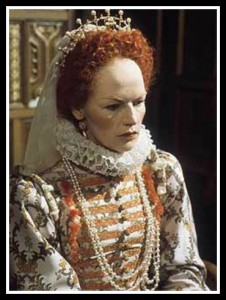
Glenda Jackson, 1971 540 minute long BBC version

Cate Blanchett, 1998/ 2005 theatrical release versions

Helen Mirren 2005 HBO miniseries

We had the opportunity to be a part of several min-biographies for the Biography Channel. Here is one on Elizabeth that you might enjoy.
If you happen to be in the UK, missing Elizabeth I places would be the trick, not finding them- there are quite a few. Like, Hatfield House and the Tower of London, and The Globe Theater.
Books: Okay here is the deal. Elizabeth I is QUITE a popular literary subject, there are a lot of books about her out there and most of them are really informative. We’ve read so many that listing them all would bore you. You really can’t go wrong with anything written by David Starkey or Alison Weir.
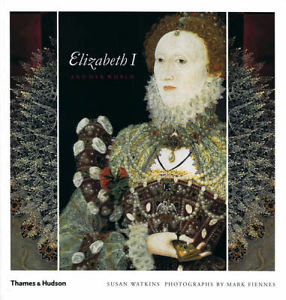
In Public and in Private; Elizabeth and Her World by Susan Watkins (Book Beckett highly recommended)

For kids- while not Tudor centered, Anne Boleyn is profiled in this first of a series by Author/Illustrator Lisa Graves (Our friend, the History Witch who we can’t talk about enough because she is pretty fabulous) HistoryWitch.com
The Tudor Tutor has a list of source material she uses (as well as A LOT of information that you might enjoy spending time with).
Since we are sharing websites, here are the ones that we talked about: (excellent for kids) Tudorhistory.org , (sistersite to Anne Boleyn files) Elizabeth Files , and Being Bess, another really terrific site, On the Tudor Trail (this link will take you to a post on Hatfield house)
So, you’re visual. Here is a link to a particularly terrific documentary- The Virgin Queen David Starkey (We told you you really can’t go wrong with Starkey)
And after that highbrow educatin’ you earned yourself a nice Horrible Histories bender.
Time Traveller’s Guide to Elizabethan England – follow this video (and book) along as historian Ian Mortimer shows what life is like for the non-regal set during this era.
This American Life Fiasco Episode!
Pottage recipe from the Elizabethan era, just like Beckett promised. (And a really interesting site for people who like to eat their way through history!)
Keen eared listeners might remember a very clever letter that we read a few seasons ago from long-time friend, Tom. He is currently living in Scotland, and offers this interesting addition to the legacy portion of Elizabeth’s story. (We didn’t talk about this during the episode, but link it nonetheless because Tom is a very loyal listener and History Nerd of the highest caliber.) Operation Highlander
And because we like to make Doctor Who references as much as we like to make Harry Potter references…the 1st Doctor visited her, the 10th visited TWICE: once with companion Martha in the Shakespeare Code…and then there was much jubilation when this happened on the 5oth Anniversary special:
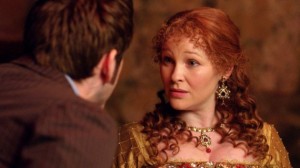
I do…what?
End song: “Leaf in the Tree”, by Frozen Ocean Wave
As always, music comes courtesy of Music Alley. Visit them at Music.mevio.com
by The History Chicks | Nov 1, 2013 | News, Podcasts
We have received our third Podcast Award Nomination in as many years! Voting starts now and the window is very short- November 1st-15th.
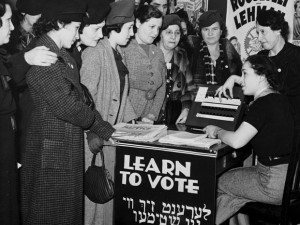
HOW TO VOTE
HERE IS THE LINK TO THE PODCAST AWARDS!
Voting is easy and very self explanatory. You get one vote per IP address a day, and a lot of the time you will have to verify your vote ( there was some shenanigans in years past). Check off your favorite shows, add your name, click submit and done.
We will be happily giving our votes to The Satellite Sisters in both the General and People’s Choice categories. If you’ve never listened, you should, it’s a fun podcast by a group of real life sisters who talk about eeeeverything!
And of course, The Bowery Boys, a history podcast so wonderful you don’t have to be in New York to enjoy it. The fellows are in the Travel category and up against a ballot FULL of Disney themed podcasts.
We will be showing our love for these two shows and ask you to vote with us. We not only listen to the podcasts, but the hosts have been very supportive of us behind the scenes since we began.

Suffragists marching costume 1916, which has very little to do with what we are talking about, but it's still cool to see.
From November 1st through the 15, please vote once a day and fill out the ballot carefully!
We won’t nag you, although we will remind you when voting is closing. This is a pretty big deal in our world and getting nominated THREE times has been really amazing to us, But we are wondering… is is third time is the charm? We’re up against some pretty heavy hitters so every vote counts. (when doesn’t it?)
Thank you for the nominations, for voting, for spreading the word to vote, but mostly thank you all for listening.
Beckett and Susan
ONE MORE LINK TO THE PODCAST AWARDS!
by The History Chicks | Sep 9, 2013 | Biography Episode, Episode, Podcasts
Put some flowers in your hair, drape yourself in bold fabrics and listen to a chat about the colorful and dramatic life and art of Frida Kahlo.
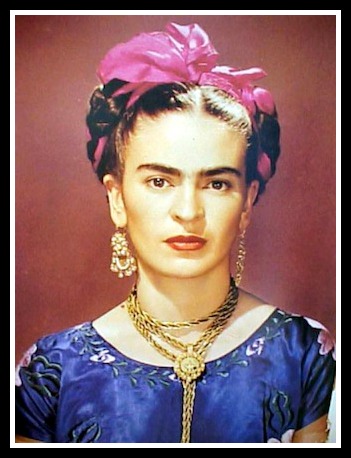
Frida Kahlo, circa 1937
If you thought selfies were an invention of the Twentytens, step back in a time a bit farther. The majority of Frida’s art was of herself- it’s how she told her story. Frida experienced a great deal of pain and joy (and every emotion in between) in her lifetime, and painting was how she expressed herself.
Born (deep breath) Magdalena Carmen Frieda Kahlo y Calderon on July 6, 1907 to Guillermo and Matilda Kahlo in Coyoacan, Mexico. She was the third of four daughters, although Papa had two girls with his first wife.
Frida’s childhood was off to a tumultuous start when the Mexican Revolution broke out when she was 3. A few years later, she contracted polio and was bedridden for most of a year. Both of these events foreshadowed some very significant challenges that would come her way.
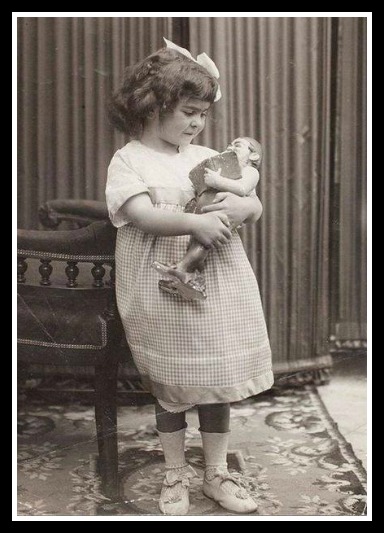
Young Frida
But first she had to grow-up! We talk about her schooling, her neighborhood shenanigans and her entre into a prestigious school to study to become a doctor. While there she gets her first taste of radical political life and she meets a man- muralist Diego Rivera. At this point, Frida’s role in his life was to taunt him while he tried to work…or play (Diego excelled at “play”).
When Frida was 18, she boarded a bus with her boyfriend, just like she did every day. But that day the bus and a trolley collided. Frida was left with severe injuries that affect her physically for the rest of her life. We do go into details during the podcast, and give a warning because the accident and recovery was horrific.
A teenager, laying at home immobilized by a full-body cast, would get bored very quickly. Her parents set Frida up with paints, a mirror over her bed and an easel- the result? Frida’s first painting- a self portrait. More paintings came and we talk about some of them. When she is finally vertical she brings a sample of her work to her former tormentee: Diego.
And he liked them!
And he liked her!
Of course we go into greater detail in the podcast, but in short order Frida and Diego marry. He was 22 years her senior and was almost a foot and 200 pounds larger but the match between, “an elephant and a dove” (as her mama claimed) was passionate and electric.

Frida and Diego, circa 1930
Diego’s job as muralist took him many places, and Frida followed. She continued to paint although her very small, mostly self-portraits juxtaposed with his large and quite full murals mirrored the physical dissimilarities that they had. The couple traveled to the United States, where she was “Mrs. Rivera” ( and not much else) but is celebrated because of her relationship to the famous painter. For a variety of reasons (that we cover, you know the podcast is much fuller than these shownotes, right?) she is not happy in the United States and eventually, they work their way back to Mexico.
But with great passion often comes great drama. Diego has never managed (or even attempted) to keep himself away from other women, and- quite frankly- Frida didn’t do such a great job keeping herself away from other women (and men), either. Their love was…er- unique. And so was their house!

Diego got the big half, Frida the shorter- and they were connected by a bridge.
And then this happened.

My Sister Cristina…yeah, *that* sister Cristina. She’s lucky this was painted before (the incident)
And things get pretty dramatic for a few years (like they weren’t before?) It’s like a telenovela…except it’s real! We do our best to keep this talk PG-13, we really do, but their lives weren’t all that PG-13. For instance, after a separation, then a reconciliation of sorts, they take in exiled Russian Revolutionary, Leon Trotsky and his wife. A short affair ensues (Frida with Leon). Later, Trotsky is killed while in Mexico: Diego and Frida are suspects for a short time, but Diego had conveniently left the country. See? Drama.
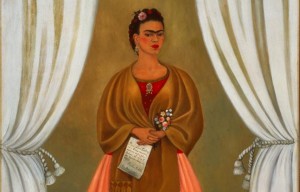
Later she painted this, Self-Portrait Dedicated to Leon Trotsky (image courtesy NMWA)(you should go read about it here)
All of the drama really fires up her art. Frida painted to work through her feelings and she clearly had a lot of feelings that needed to be addressed. Because of that, her art was beginning to get noticed. She was given several exhibits in both New York and Paris.
Paris loves her!

Josephine loves her! Maybe. Probably.
The Parisians adore her style and slap her on the cover of Paris Vogue.
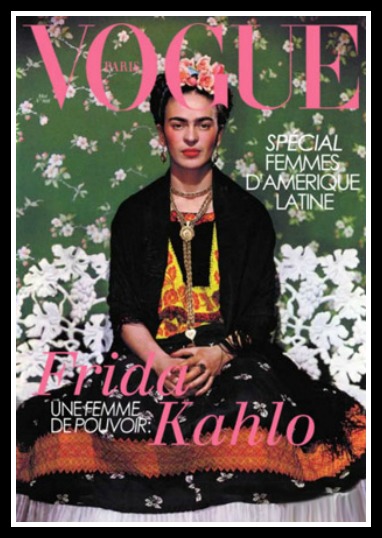
Because everyone who goes to Paris gets a Vogue cover. Vogue. Vogue.(two points if you just got a Madonna earworm)
But she and Diego need eachother. Somehow. They work out an amiable arrangement and get married again. For several years she takes care of him, he takes care of her…they move back into the Casa Azul and have a colorful and workable relationship.

Frida painting her father, Guillermo’s portrait circa 1951
But Frida’s health has never been good. Several pregnancies that never came to term took a toll on her body, as well as lifelong complications from her bus accident. She spends the better part of her last years in bed or hospitalized.
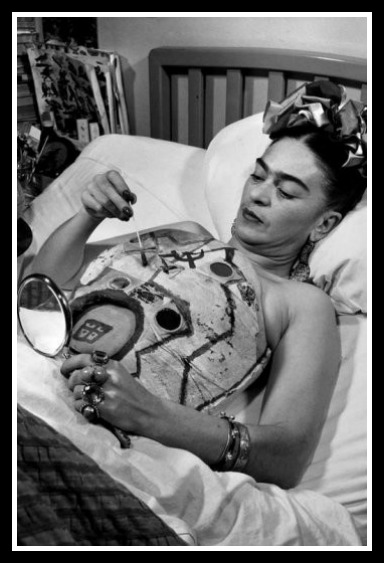
Frida painting in a hospital bed later in her life

Frida’s last painting, completed just before her death
On July 13th, 1954, at the age of 47, Frida Kahlo dies at her home. Official cause: Pulmonary Embolism. Unofficial Speculation: suicide or assisted suicide.
Her remains were cremated and are still on display at Casa Azul.
TIME TRAVEL WITH THE HISTORY CHICKS
You want to look at lots of pictures of Frida- you must! She told her biography through her paintings, and there are a lot of images of her to be seen. Click on over to the Frida Kahlo Museum, or The Frida Kahlo Foundation to get started. The first you can visit and is located in her family home, Casa Azul in Coyoacon, Mexico.
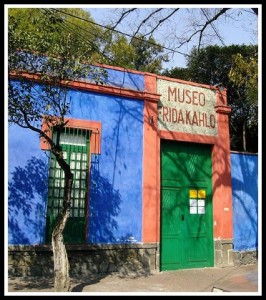
Frida Kahlo Museum
Here is the link (about a documentary) that we spoke about where you can roll your mouse over some of her art for explanations, Life and Times of Frida Kahlo, PBS.
San Francisco Museum of Modern Art. Beckett talked about this. Click on RELATED MULTIMDIA to start your adventure.
Movie version!

BOOKS! Start with the books Susan recommended. First up, historical fiction:
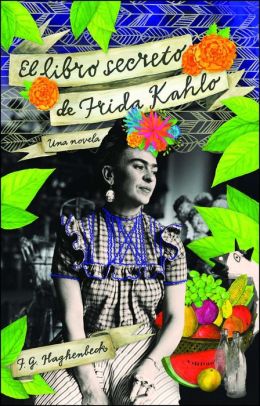
The Secret Book of Frida Kahlo by F.G. Haghenbeck (recipe for Nonnie and anyone else in Special Features)
For the most part, we both really appreciated the books the showed her life along side her paintings- it’s the perfect way to understand both. If you find one, even ones we don’t recommend here, grab it. There are many exceptional art books about her out there.

by Gerry Soufer
Loved this one…Self Portrait in a Velvet Dress: Frida’s Wardrobe

Fun children’s book by Amy Novesky, illustrated by David Diaz
We forgot to mention this one, but it was really great for kids:

Viva la Vida by Carmen T. Bernier-Grand
Beckett’s recommendations:
by Hayden Herrera

Another art book…Edited by Elizabeth Carpenter
As always, music comes courtesy of Music Alley. Visit them at Music. mevio.com


































